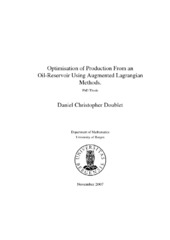| dc.description.abstract | This work studies the use of augmented Lagrangian methods for water flooding production optimisation from an oil reservoir. Commonly, water flooding is used as a means to enhance oil recovery, and due to heterogeneous rock properties, water will flow with different velocities throughout the reservoir. Due to this, water breakthrough can occur when great regions of the reservoir are still unflooded so that much of the oil may become ”trapped” in the reservoir. To avoid or reduce this problem, one can control the production so that the oil recovery rate is maximised, or alternatively the net present value (NPV) of the reservoir is maximised. We have considered water flooding, using smart wells. Smart wells with down-hole valves gives us the possibility to control the injection/production at each of the valve openings along the well, so that it is possible to control the flowregime. One can control the injection/production at all valve openings, and the setting of the valves may be changed during the production period, which gives us a great deal of control over the production and we want to control the injection/ production so that the profit obtained from the reservoir is maximised. The problem is regarded as an optimal control problem, and it is formulated as an augmented Lagrangian saddle point problem. We develop a method for optimal control based on solving the Karush-Kuhn-Tucker conditions for the augmented Lagrangian functional, a method, which to my knowledge has not been presented in the literature before. The advantage of this method is that we do not need to solve the forward problem for each new estimate of the control variables, which reduces the computational effort compared to other methods that requires the solution of the forward problem every time we find a new estimate of the control variables, such as the adjoint method. We test this method on several examples, where it is compared to the adjoint method. Our numerical experiments show that the method is convergent, and when comparing it to the adjoint method it converges faster, in terms of computational effort, than the adjoint method. Furthermore, the method is also applied to a history matching problem, where we estimate permeabilities. Also for this problem, the method shows good results. This work studies the use of augmented Lagrangian methods for water flooding production optimisation from an oil reservoir. Commonly, water flooding is used as a means to enhance oil recovery, and due to heterogeneous rock properties, water will flow with different velocities throughout the reservoir. Due to this, water breakthrough can occur when great regions of the reservoir are still unflooded so that much of the oil may become ”trapped” in the reservoir. To avoid or reduce this problem, one can control the production so that the oil recovery rate is maximised, or alternatively the net present value (NPV) of the reservoir is maximised. We have considered water flooding, using smart wells. Smart wells with down-hole valves gives us the possibility to control the injection/production at each of the valve openings along the well, so that it is possible to control the flowregime. One can control the injection/production at all valve openings, and the setting of the valves may be changed during the production period, which gives us a great deal of control over the production and we want to control the injection/ production so that the profit obtained from the reservoir is maximised. The problem is regarded as an optimal control problem, and it is formulated as an augmented Lagrangian saddle point problem. We develop a method for optimal control based on solving the Karush-Kuhn-Tucker conditions for the augmented Lagrangian functional, a method, which to my knowledge has not been presented in the literature before. The advantage of this method is that we do not need to solve the forward problem for each new estimate of the control variables, which reduces the computational effort compared to other methods that requires the solution of the forward problem every time we find a new estimate of the control variables, such as the adjoint method. We test this method on several examples, where it is compared to the adjoint method. Our numerical experiments show that the method is convergent, and when comparing it to the adjoint method it converges faster, in terms of computational effort, than the adjoint method. Furthermore, the method is also applied to a history matching problem, where we estimate permeabilities. Also for this problem, the method shows good results. Moreover, we consider the augmented Lagrangian method, for optimal control problems. We study several marching schemes, that have previously been used to solve optimal control problem, and we develop a new marching scheme. Examples are tested with the new marching scheme and compared to other known marching schemes. From our experiments, we see that the scheme is convergent and that it find higher NPV than the marching schemes which we compare it to. | en_US |
